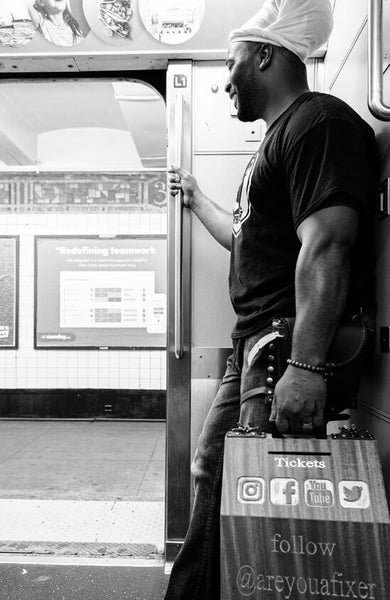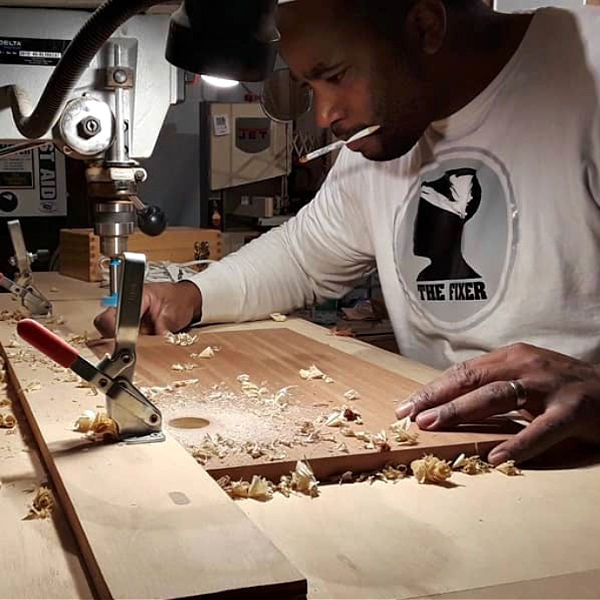Photography courtesy of dKol Photography
Tyreik Jackson shouldn’t be a happily married (going on 10 years) man with three children, a house, a successful business, and zero financial concerns. He’ll be the first person to tell you that.
He was born into public housing in Brooklyn, and a cursory glance at statistics will tell you that kids born into the projects often stay there for the rest of their lives.
Right now, almost 40% of American kids are spending at least a year in poverty before they turn 18, and kids from low-income families are seven times more likely to drop out of school than their peers. That feeds the cycle of course: 86% of kids whose parents have less than a high school diploma live in low-income families, and 67% of kids with parents who have a high school degree but no college live in poverty.
Thankfully, due in large part to strong women (his mother Dianne and his wife Monica), he didn’t just break the cycle, he broke the mold and launched a successful carpentry and home rehab business, remaking homes all over the tristate area. Now, he hopes to use his good fortune to pay it forward for others, in a — for him — typically untypical way. Jackson grew up in a broken system, but he also believes that subtle shifts in our perspective on opportunity and joy will go a long way toward healing and fixing it. For us, for now; but also for the future.
Please read on for more about Jackson’s vision for a better future.
NEW YORK MAKERS: How did you get into carpentry?
TYREIK JACKSON: Oh wow, that’s a long story. I grew up in the projects in Brooklyn, but my upbringing was anything but standard. My mother is a force, and she instilled that drive in me. As a kid she would have me hanging flyers all over the buildings we lived in informing tenants of upcoming meetings and getting them involved with concerns in the surrounding community. She didn’t stop in the building though. She became the tenants' association president and became a voice not just for our family and building, but for the whole community. She worked with members of Congress to make sure funding was allocated properly within the community, she worked with members of law enforcement to make sure people were taken care of, but not over-policed. She even made sure she was on top of building repairs and recruited surrounding businesses to give back to the community. Meanwhile, for most of my best friends growing up, and everyone we hung around with, they really thought the only way out of the neighborhood was by becoming an athlete or a rapper. I grew up understanding that those weren’t my only options. Unfortunately, and it breaks my heart every day, but most of my friends from childhood are either in the box or in the dirt. I knew I had other options, so I went to school to become a carpenter.

NYM: What is your primary focus?
TJ: I have been working for more than 20 years, starting with rehab projects all up and down the island of Manhattan and throughout the Tristate. I’ve been lucky enough to work alongside incredibly gifted craftsmen and women in million and even multi-million renovations. I can go in and gut a place and rebuild it from the bottom up, but I also love making beautiful pieces of furniture and home accents. During that time I also started a family, had three amazing kids, and every penny we had got invested into my business or real estate. My wife is my partner, and every decision we made, we made together. We’ve been incredibly lucky, and I wake up every day thanking the grace of God, my perseverance, and my curiosity for where I am. But I feel like my luck shouldn’t be the exception to the rule. I’m a fixer. That’s the name of my business, The Fixer. I wanted to fix more than furniture. I wanted to show kids that there are other ways to be successful, and I also wanted to bring real joy into people’s lives. Joy and beauty, to people who don’t have much.


NYM: So how did you go about it?
TJ: I had this idea to crowd-fund opportunity and joy. I wanted to show people what can be accomplished with just your own two hands and an idea. My initial plan was to build furniture, pieces that might cost up to $5,000 if I sold them, and give them away for free on the subway through a raffle system. I launched a social media presence, with platforms on Twitter, Instagram, YouTube, and Facebook, and I hoped that by engaging people in my mission, that I could grow an audience, increase the size and scope of the giveaways, and in the process, raise money, which would then be used to teach interested people basic carpentry skills while rehabbing their homes that are in need of repair.
NYM: How does the raffle work?
TJ: I started it in January. First, I built a wooden backpack that gave a basic outline of my mission, with The Fixer logo. I’d started by getting on the A Train in Harlem and taking it all the way downtown. That’s where it gets tricky. There’s a real fear factor getting on a subway and interrupting everyone who’s trying to mind their business with your pitch. I tried to make it short and sweet and fun, and I explained that I was giving away tickets for a raffle, and that the person with the winning ticket — announced every Saturday at 12 pm on Instagram — would end up with an original piece of furniture or decoration, made by me. I explained the larger mission and said I’d accept donations for future projects, but that it wasn’t necessary if they wanted to play. Once one person was brave enough to take me up on it, I’d give them the ticket, and then they’d stand up and drop the ticket in the backpack. That got the ball rolling, and often by the time I moved into the next car everyone was smiling, even if they didn’t take a ticket. Over the next six weeks, there was a huge surge of interest, and I built word on social media, even engaging with other craftspeople and artisans who were interested in getting involved. I was psyched. The giveaways went well too: I started small, with charcuterie boards and wall organizers, but the winners loved them and often shared them on their own social media pages, which just spread the word and love.

NYM: Let me guess. Then COVID hit.
TJ: It did. My wife and I agreed that it was too risky for me to continue on the subway. Right now, the in-person component is on hold. I could move to online crowdfunding, but to me, it defeats the purpose. I love the in-person exchange, that’s what it’s about. Reaching out, engaging with people who might be different than you, have a different story. But maybe you can learn from each other. You don’t get that online. But you know what? I’m using this time to make sure I work out the details of the next stage. How people should qualify and apply to either apprentice with me or have their space fixed for free.
NYM: So what’s next?
TJ: Let’s pray that this coronavirus situation gets resolved sooner. And follow me on social media! I’ll let you know when I’m hitting the subway again.

Consider it done.


Leave a comment